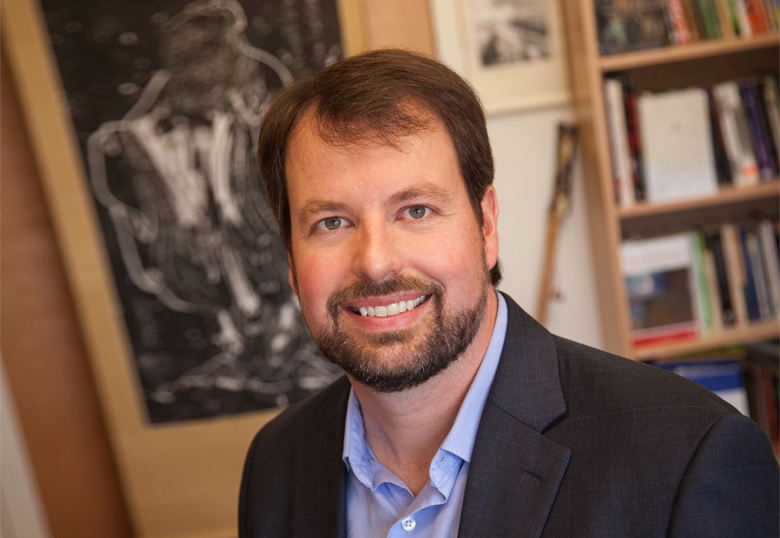From its 2,500-year-old roots in eastern India, Buddhism has evolved into the fastest-growing philosophical religion in the West, one that has sparked diverse groups of practitioners — including many celebrities — spawned countless books, and is often glamourized in Hollywood films. Dr. John Harding wants to know why.

More specifically, the University of Lethbridge Religious Studies associate professor would like to better understand the forces that have shaped Buddhism since it crossed continents from Asia into Europe and North America 150 years ago. He hopes to debunk the common misconception of modern Buddhism, particularly as it is practised in Canada, as primarily influenced by the West, and demonstrate that Asian reform movements prominently contributed to Buddhism’s global transformation.
“The more we looked into the history…the more clear it becomes that a lot of the characteristics of modern Buddhism that are viewed as Westernized actually started in Asia,” says Harding, who also chairs the Religious Studies department and coordinates the Asian Studies minor program. “We need to look at all of the global linkages, and introduce a little more theoretical sophistication to how we explore Buddhism in the West.”
It’s an area Harding has been investigating since 2013 with colleagues at McGill and St. Mary’s universities as part of a five-year research project funded by a $258,000 grant from the Social Sciences and Humanities Research Council. He recently presented on the topic at a U of L PUBlic Professor Series lecture called Buddha’s World Tour: Global Buddhism in the Modern Era. As he explains, today’s version of Buddhism is viewed as being a reflection of Western social values: egalitarian, female friendly, based in meditation and socially engaged. At the same time, there is a perception of traditional Asian Buddhism as hierarchical, sexist, ritualistic and withdrawn from society.
In fact, he says, this shift to what many Westerners call the “new Buddhism” evolved organically in countries such as Sri Lanka, Japan, China, Taiwan and Vietnam. Typically, these changes occurred in response to pressures such as Western colonialism and aggressive Christian missionization. Monks travelling between the different Asian countries observed these changes and started their own Buddhist reform movements at home. What eventually emerged, Harding says, was a radically different form of Buddhism that, with the growth of population movement and global communication, began to spread worldwide.
Harding’s interest in the subject goes back to his time as an undergraduate student at the University of Puget Sound in Washington in the early 1990s, when he completed his thesis on changes in Buddhism in Japan in the late 1800s. At that time, he says, reformers were responding to domestic criticism that the religion wasn’t relevant in the modern world. From that point on, through his graduate studies at the University of Pennsylvania and since joining the U of L in 2003, he has studied extensively and published widely on the development of modern Buddhism worldwide.
“I find it quite fascinating that our culture and surroundings can be significantly shaped by forces and influences we know almost nothing about…I’m particularly interested in different perspectives that shape how people think about their own life and their world and how it’s unfolding,” says Harding, who often seeks to involve undergraduate and graduate students in this research.
Harding and his research colleagues are now one-third of the way through their latest research project with the support of the SSHRC grant. In the last five years, the three colleagues have published two books that analyze the dramatic growth of Buddhism in Canada in global and historical contexts, Wild Geese and Flowers on the Rock. Going forward, Harding says he hopes their research results help improve the scholarship in the nascent fields of Global Buddhism and of Buddhism in the West by setting the historical record straight on the hows and whys behind the new Buddhism. As well, he says, a clearer understanding of the origins of modern Buddhism will help us better understand Canada’s cultural mosaic. Finally, practitioners of Buddhism in Canada may be interested to learn about the cross-cultural exchange between Asia and the West that helped form Buddhism as we know it today
“There is an impression that Buddhism in the West has become a bit of a quick fix for a fast food culture, and many people’s understanding of it is quite shallow,” he says. “In fact, there are many variations of the tradition influencing culture at multiple levels, and if one of the concerns is authenticity, this study can reflect how Asia played a role in the modernization of Buddhism.”
